|
Size: 7246
Comment:
|
Size: 9193
Comment:
|
| Deletions are marked like this. | Additions are marked like this. |
| Line 4: | Line 4: |
== April, 20th (Thursday) == [Hervé & Juan 00h00-08h00] We continue observing the cluster: {{attachment:psz2g144_1mm.pdf||height=400}} {{attachment:psz2g144_2mm.pdf ||height=400}} Then, we started a session in M99 that lasted for about 2 hours of observation in total. {{attachment:m99_1mm.pdf||height=400}} {{attachment:m99_2mm.pdf ||height=400}} We finally did another session of quasar observations to test the gain elevation curve. [Samuel & Laurence, 8:00-16:00] Check list green (turbo pump: Tbottom about 25 deg Celsius; T mixing chamber about 182 milliK; cryo levels TBC; tunning OK) ''Beammap session'' We did a defocused beammap sequence on Neptune beginning at an elevation of 30 deg: scan ID 20170420113-117. Then we did 4 beammaps at optimal focus on Mars at various elevation, namely 20170420s135 is around 30deg, 20170420s154 around 50 deg, 20170420s174 around 60 deg and 20170420s188 around 70 deg. Preliminary gain vs elevation determination (NP): The first plot shows the flux of each source vs elevation for the currently available scans ('''no opacity correction applied but I assume a constant opacity and correct for the air mass'''). The second plot gathers all the sources vs elevation for each array. The fluxes are normalized to their value at 40 deg. elevation. The consistency so far is remarkable, thanks to constant X and Y focus throughout the observations ! On the second plot, the black line is a fit on all observations, the pink curve is the EMIR curve displayed for comparison. Although the fits look good, it's possible that further analysis (involving opacity correction) discards some of these scans, so if possible, it would be good to have one more sequence of monitoring these sources on the full range of elevations. {{attachment:all_gain_vs_elevation_n2r10_v1.png||height=300}} {{attachment:all_gain_vs_elevation_n2r10_1_v1.png||height=300}} [Alessia & Andrew, 16:00-24:00] As we start observing, everything on the instrumental side is working okay. As was the case yesterday, weather conditions are somewhat unstable at the start of the shift, despite blue skies outside, and tau is hovering around 0.36. We want to make sure we are happy with the pointing and focus on 0716+714 near Florian's cluster, before we start observing the latter as our first science verification target. |
|
| Line 28: | Line 56: |
| [Alessia & Andrew, 16:00-20:00] | [Alessia & Andrew, 16:00-00:00] |
| Line 33: | Line 61: |
| [Hervé & Juan 00h00-08h00] We continue observing the cluster: {{attachment:psz2g144_1mm.pdf||height=400}} {{attachment:psz2g144_2mm.pdf ||height=400}} Then, we started a session in M99 that lasted for about 2 hours of observation in total. {{attachment:m99_1mm.pdf||height=400}} {{attachment:m99_2mm.pdf ||height=400}} We finally did another session of quasar observations to test the gain elevation curve. |
Back to the NIKA2 run 10 main page
April, 20th (Thursday)
[Hervé & Juan 00h00-08h00] We continue observing the cluster:
Then, we started a session in M99 that lasted for about 2 hours of observation in total.
We finally did another session of quasar observations to test the gain elevation curve.
[Samuel & Laurence, 8:00-16:00] Check list green (turbo pump: Tbottom about 25 deg Celsius; T mixing chamber about 182 milliK; cryo levels TBC; tunning OK)
Beammap session We did a defocused beammap sequence on Neptune beginning at an elevation of 30 deg: scan ID 20170420113-117. Then we did 4 beammaps at optimal focus on Mars at various elevation, namely 20170420s135 is around 30deg, 20170420s154 around 50 deg, 20170420s174 around 60 deg and 20170420s188 around 70 deg.
Preliminary gain vs elevation determination (NP): The first plot shows the flux of each source vs elevation for the currently available scans (no opacity correction applied but I assume a constant opacity and correct for the air mass). The second plot gathers all the sources vs elevation for each array. The fluxes are normalized to their value at 40 deg. elevation. The consistency so far is remarkable, thanks to constant X and Y focus throughout the observations ! On the second plot, the black line is a fit on all observations, the pink curve is the EMIR curve displayed for comparison. Although the fits look good, it's possible that further analysis (involving opacity correction) discards some of these scans, so if possible, it would be good to have one more sequence of monitoring these sources on the full range of elevations.
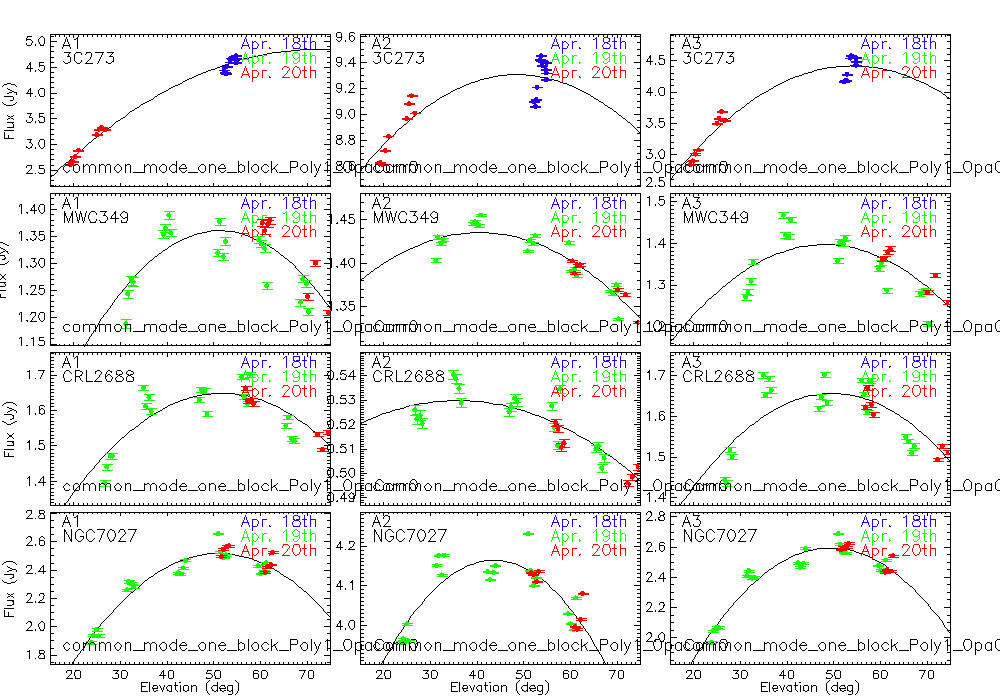
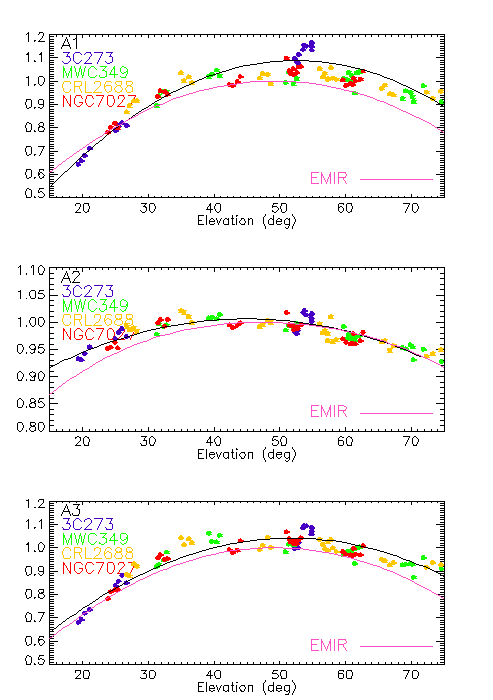
[Alessia & Andrew, 16:00-24:00] As we start observing, everything on the instrumental side is working okay. As was the case yesterday, weather conditions are somewhat unstable at the start of the shift, despite blue skies outside, and tau is hovering around 0.36. We want to make sure we are happy with the pointing and focus on 0716+714 near Florian's cluster, before we start observing the latter as our first science verification target.
April, 19th (Wednesday)
[Samuel & Laurence, 8:00-16:00] check list: turbo pump working fine, mixing chamber temperature stable around 182 milliK, cryostat inclination stable, number of tuned kids good
Observations: We did a first beammap on Neptune (20170419s124), then 2 otf maps of Neptune for calibration stability checking while the temperature of the telescope stabilizes after the Sun has risen. We did a defocus beammap series on Neptune (20170419s133-137). Then we moved to Mars for having higher signal and did another beammap (20170419s151). The atmosphere begun to being very unstable at 11:30 UTC. We could not even focus on Mars. We moved to a small dark test session to check the f_tone values and then did a skydip.
Analyses: starting the analysis of 20170419s124. The antenna imbfits was missing, we generated it using the procedure described in http://www.iram.es/IRAMES/mainWiki/HowToForObserversNika2Run1. The produced imbfits file generates error messages while producing the kidpar (nk_error: wrong imbfits file). We called Albrecht, who told us where to find the files on mrt-lx3 and scp-ed them to nika2-a imbfits_dir by hand. Later on, we learnt that launching nk_rta on each beammap scan would have done it...
Below you will find preliminary results on a geometry from a beammap scan on Neptune (scan ID: 20170419s133). This geometry (red ellipes) is compared with a geometry from one of our best beammap acquired during the 2 previous runs N2R8&9 (blue ellipses).
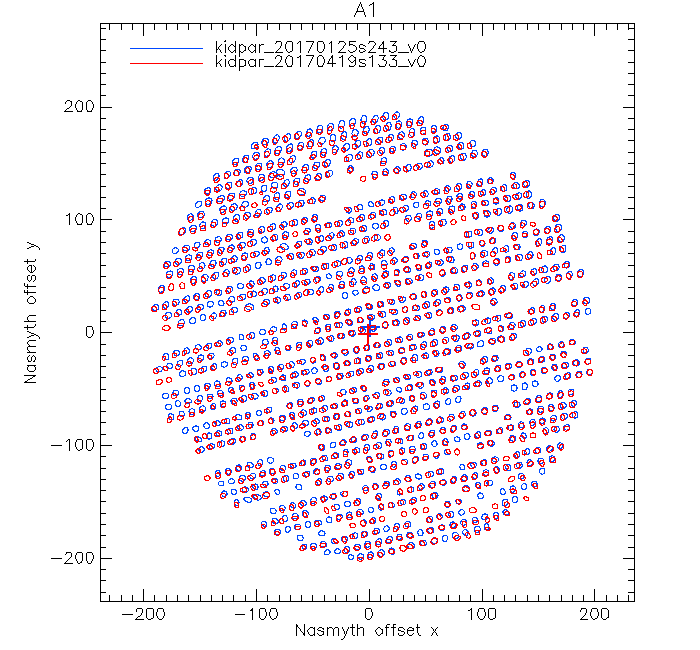
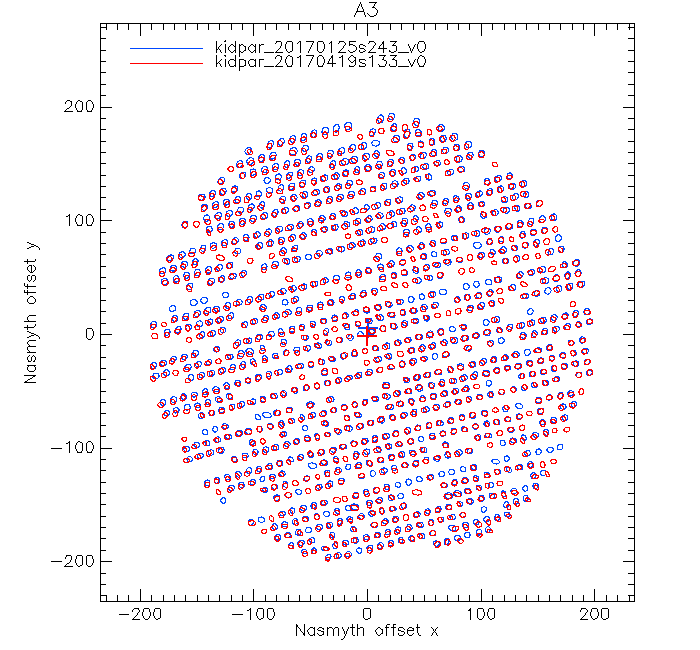
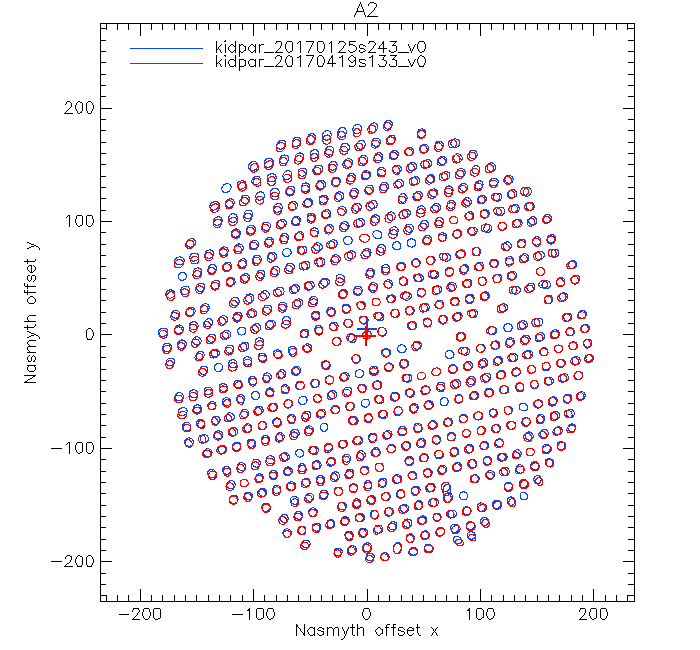
Average geometrical FWHM (from an 2D Gaussian fit) are:
kidpar: kidpar_20170419s133_v0
- A1 fwhm = 10.7 pm 1.0
- A3 fwhm = 10.7 pm 0.9
- A2 fwhm = 16.5 pm 0.6
Note that beams are smaller than the N2R8 beams in the outter regions of the arrays (no beam broadening effect) whereas equivalent to N2R8 beams in the central region. This indicates better beams in average as expected when the focus is set to the best average value, i.e. best central value -0.2 mm.
[Alessia & Andrew, 16:00-00:00] Poor and unstable weather conditions. Tau=0.4. 18h : since it was not possible to observe, not possible to focus on Mars, Santiago went up in the cabin to open the plastic window on the vertex trying to refresh the cabin air a bit more. 20h : we finally found the best focus and we've started the observation of the galaxy cluster with an opacity almost stable to 0.3.
April, 18th (Tuesday)
Start of the official run.
First things first: verification of the alignment (since it changed for an unknown reason between run 8 and 9!)
- Expectations: Radio axis has been measured (see run 8 daily report) to be 5mm left from centre (toward the M4 wall), and 1.5mm up from centre (toward ceiling).
- Measurement radio with ecosorb plate: roughly centred at +/- 3-4mm ; sky is too noisy to get better accuracy, so it's compatible with previous measurement; we will double check once the sky is good (it takes only about 10 minutes to check)
- Measurement laser spot on window removing M3 mirror: 3.5mm +/- 0.5mm up from centre when at 85° elevation, and 4.5mm +/- 0.5mm when at 0° elevation ; 3.5mm +/- 0.5mm left from centre when at 85° and 0° elevation.
==> ~2.5mm too high and ~1.5mm too much right w.r.t radio axis. Given the measurement errors and the expected effect on pupil illumination of the primary we think it's preferable to let it as it is. Indeed below you can see the Zemax simulations of illumination of the primary by various field taken over the FOV (various positions on the array) with a good alignment and with the offsets we measured. The effects on the beam are negligible (changes of structure at 10-3 level), it's also negligible for pointing. Zemax can't simulate the effects on the real data quality of the asymmetric illumination of the primary; we can just infer that as long as we stay inside M1 we should be fine, though we might have a small increase of background due to slightly higher spillover.
AlR,AR [16h00-00h00]: We start the observations in poor weather (tau=0.5), and without a properly functioning turbo pump. Since Mars is bright, we intended to follow it for some beam maps, though by the time we managed to get focused, the turbo pump was having trouble and the cabin was too warm again. Once the cabin was cool again, Mars was too low, so we moved onto the quasar 3C273, though it was too faint at 1mm to make any sensible conclusions about the focus. After this, we targeted the nearby quasar 3C279, which is a bit bright, and were able to get focused successfully. Given the weather conditions and the lack of other bright targets, we carried out OTF maps of the QSOs 3C273 and 3C279 at different elevations.
HA and JFMP [00h00:08h00]: During the night the average tau was 0.3 and very stable. We continue observing the two QSOs 3C273 and 3C279. We also did a beammap in 3C279. After that we switched to secondary calibrators (NGC7027, CRL2688 and MWC349) observations at different elevations. We repeated the same commands than for the QSO, doing OTF maps in azel and RADEC , and in az and elevation. We also performed some skydips.
April, 14th (Friday)
Alessia at the telescope and Juan remotely.
We started doing two dark scans. We tried to point using 3C84 but the source was far from the center -38,-20 arcsec. After discussions with Juan Peñalver we decided to use nasmyth offset computed by Nicolas on run 9: offsets -18.8 -5 /sys nasmyth, However, this did not solve either the problem. We switched to Mars but encountered the same problem. Finally, we found that the problem was related to a wrong reference kidpar - we corrected this and everything started work fine. However the weather during the day was very unstable although tau was not that bad: about 0.3-0.4 from IRAM taumeter. We have performed a small pointing session to verify the current model. We tried to get some Mars beammaps after focus X,Y, Z. We did a couple of skydips. Finally, we tried to go to PSZ2G144.85 to do a first test but had no enough time. Really a pity because the weather improved quite a lot.
Alessandro 22h45. I stop the turbo for the weekend. Plan to switch it ON on Monday in the late evening. Alessia, could you put the NIKA2 window back in place so we can check the noise between Monday and Tuesday ? Good night !
